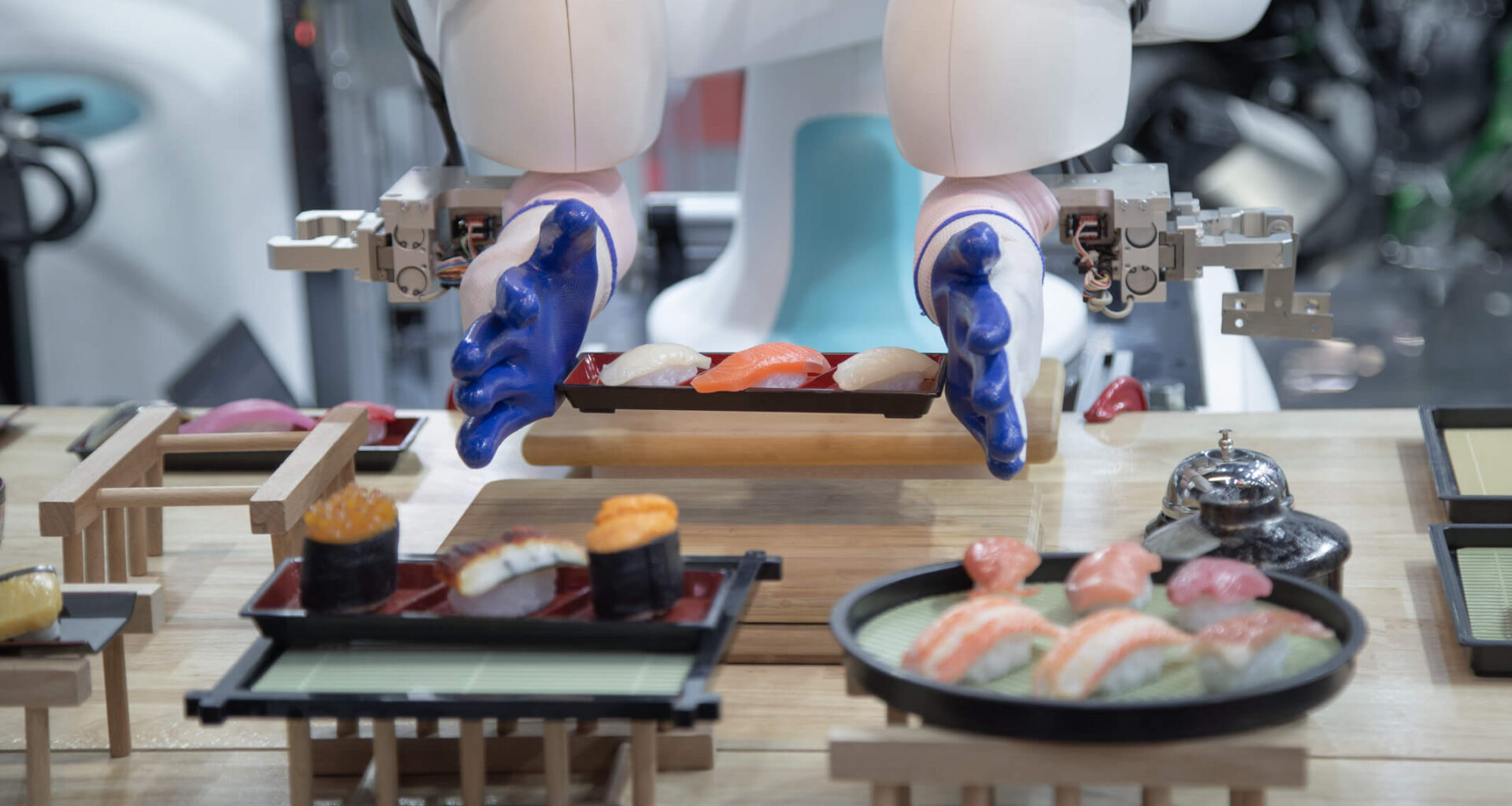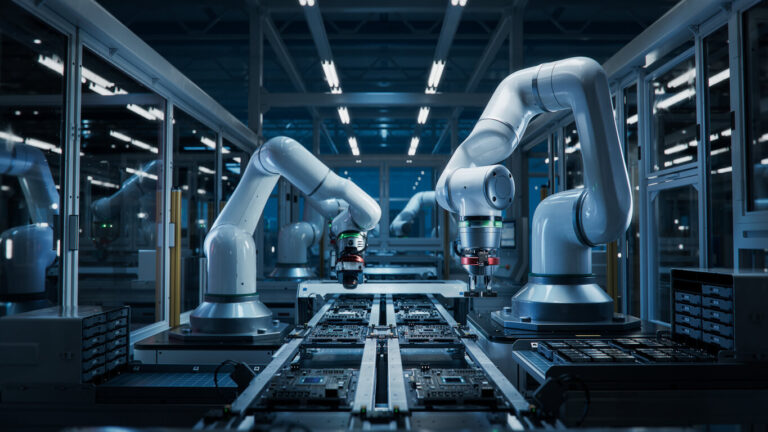Food processing has become an important field for robot utilisation to assist in the process of food production, delivery and distribution.
With the rise of robotics in many industries, food and beverages is one of the key markets for automation technologies and the advancement of robotics. As a beacon of innovation, robotic solutions promise to redefine efficiency, safety, and quality in food production as the industry struggles with enduring issues including labour shortages, strict safety standards, and the continued demand for high-quality products.
If you are wondering how robots are taking over the food industry, you are in the right place. Keep reading to learn more about robots and their role in the food industry.
How Are Robots Used in Food Processing?
The food processing industry is undergoing a substantial shift due to the incorporation of advanced robots that possess artificial intelligence (AI), cooperative robots (cobots), industrial robots or industrial robotic arms, as well as specialised equipment meant for various functions such as packaging, sorting, picking, and careful quality checks.
With their sophisticated sensor technologies and machine vision systems, these technical wonders are more than simply machines—they are the future workforce, able to handle even the most delicate food products with care and precision. With the technology behind the rise of robots, the future is here and is also impacting the food sector.
Robotic Solutions in Food Production
Food processing is one of the industries with the widest range of robotic applications. Robotic solutions are becoming more and more prevalent in a variety of fields, including the handling of perishable fruits and vegetables and the labour-intensive operations associated with producing meat and poultry. Robots are not only increasing production speeds in the dairy and baked goods industries, but they are also essential for specialised jobs like cake decoration and artisan cheese packaging that require extreme precision.
Using robot arms in bakeries is one such example; these arms are designed to decorate cakes with elaborate designs that would take a lot of time and effort for human workers to complete. Similarly, robotic butchers that are equipped with very precise cutting tools in the meat processing industry can achieve levels of efficiency that exceed human capabilities by precisely cutting meat while minimising waste.
Top 6 Robotic Applications in Food Processing
Robotic technology is being quickly adopted by the food processing industry in order to improve productivity, security, and food hygiene. Here are the top six robotic applications that are having a big impact on food processing out of all the many applications:
1. Sorting and Grading
Robotic Vision Systems: With the use of sophisticated vision systems, food items can be sorted by size, colour, ripeness, and quality by robots. Robots with cameras and sensors, for instance, may swiftly and precisely sort goods in the fruit and vegetable business, making sure that only items that fit predetermined standards move on in the food manufacturing line.
Robotic Arms: Robotic arms are essential to the transformation of food processing processes because they are efficient, precise, and versatile in a wide range of applications. For instance, to sort and grade food products according to size, colour, weight, and quality, robotic arms are incorporated with sensors and image technology. Only items that fulfil certain requirements move forward down the production line thanks to industrial automation of the quality control process.
The intuitive robotic arm, xArm, from UFactory is a perfect tool for material removal, finishing, welding, assembly, dispensing, material handling and quality inspection.
2. Cutting and Deboning
Robots with great precision: In the processing of meat and fish, robots perform operations including cutting, deboning, and filleting. These robots can execute jobs that are difficult and dangerous for human workers, making accurate cuts to maximise production and decrease waste.
3. Packaging and Palletising
Collaborative robots (Cobots): Package food items securely and effectively by collaborating with human operators. They may be simply programmed for various duties and are made to handle a wide range of products, from larger commodities like meat packages to delicate ones like eggs.
For example, the collaborative robots from OMRON are designed to assist with assembly, packaging, inspection, and logistics while working alongside people. With varying payloads and sizes, OMRON offers a range of models that ensure the ideal reach and payload for various applications. Have a look at the video below to see how the OMRON collaborative robot works.
Palletising Robots: These machines automate the process of packing food items into pallets for transport. They greatly expedite the food packaging process and lessen the physical strain on human workers because they can carry high loads and operate nonstop.
3. Cooking and Preparation
Automated Cooking Systems: The fields of food preparation and cooking are also being affected by robots. Automated systems are capable of precisely and consistently completing operations like mixing, baking, and frying, guaranteeing consistently excellent results. These technologies are very helpful in mass production environments, such as the manufacturing of snacks and prepared meals as well as in the restaurant and hospitality industries – restaurant robotics are becoming more popular.
4. Inspection and Quality Control
Machine Vision for Inspection: Food products can be inspected for flaws, contamination, and irregularities at different phases of manufacturing by food robotics that are outfitted with machine vision. Only goods that adhere to the strictest food quality requirements are sent to customers thanks to this real-time inspection.
Robots from ABB are quick, agile, and flexible—even in the face of rigorous hygiene requirements. They are made to fit every facet of the many food and beverage industry processes, supporting clients in their quest to boost output and enhance final product quality.
5. Cleaning and Sanitisation
Robotic Cleaning Systems: It’s critical to maintain hygienic conditions in food processing facilities. Deep cleaning activities can be carried out by robots fitted with cleaning and sanitising equipment. These machines can reach locations that are challenging for human personnel to clean efficiently. This lowers the possibility of foodborne infections while also enhancing the facility’s general hygiene.
6. Customisation and Decoration
Decorating Robots: In the bakery and confectionery industries, robots are capable of precisely and artistically decorating cakes, biscuits, and other goods. These robots can reliably reproduce complex designs, which improves the products’ visual attractiveness.
Are Robots The Future of the Food Industry?
AI and machine learning will be more deeply integrated into robotic food processing methods in the future, allowing robots to learn from their surroundings and gradually become more efficient. More flexible and adaptive robotic systems that can do a greater range of activities with less assistance from humans may result from this.
The development of robotic solutions will be essential to the creation of more effective and zero-waste food processing techniques as the world’s attention turns increasingly towards sustainability. In doing so, the production processes for food can be made more sustainable overall, minimise product loss, and maximise energy use.
In addition to addressing present industrial issues, the use of robotics in food processing opens the door to a safer, more effective, and sustainable food production system in the future. The potential uses of robotics in the food business are only going to grow as technology develops, drastically altering the way that food is produced.












